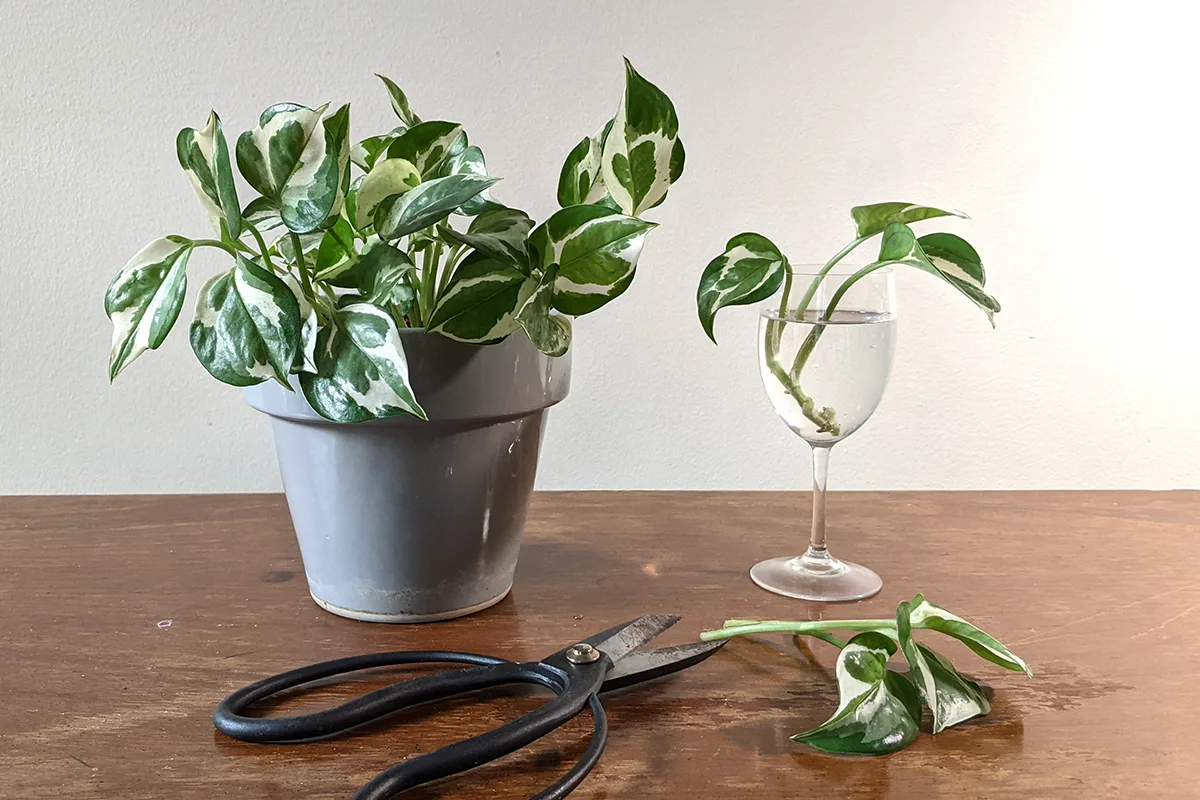
I have been growing (and killing) houseplants for decades, and after years of experience, pothos has become my go-to houseplant. They’re beautiful, lush, easy to get your hands on, even easier to make more of, and nearly indestructible. Whether I need a nice last-minute gift for someone or there’s a corner that could use (even more) greening up, most of the time, I’m looking for a pothos.
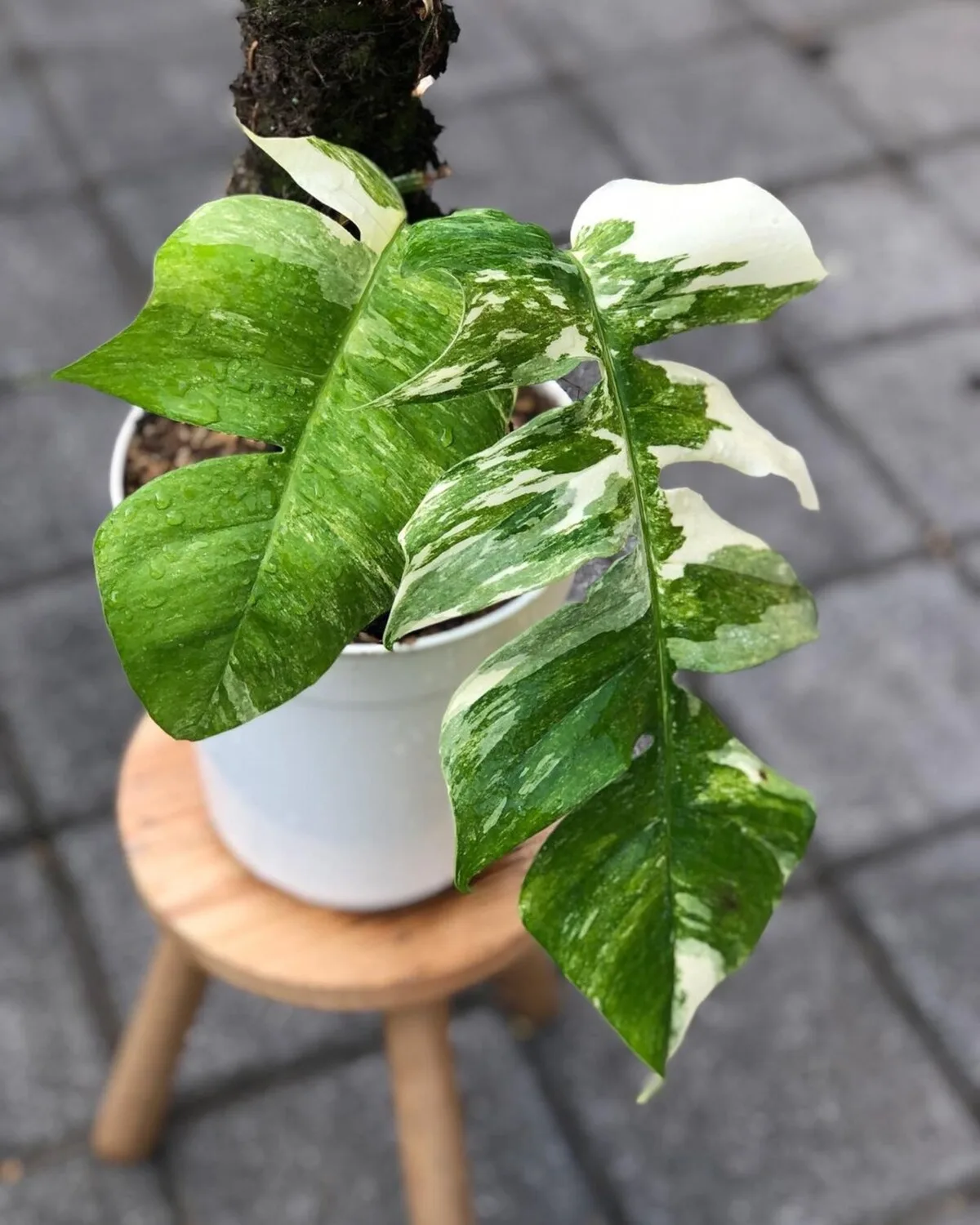
What I’m about to say will make me sound like the biggest hipster: I was growing houseplants long before the current houseplant craze. Granted, back in the day, it was only a not-so-Christmas cactus started from a cutting from my grandmother, a spider plant and a few African violets.
Over the years, I’ve gone through my share of plant-crazed purchases.
I’ve grown them all: maranta, ZZ plant, Monstera deliciosa, Monstera adansonii, fiddle-leaf fig, and dumbcane. Some of them I still have, and many of them were given away to friends. And yes, a few died along the way; I’m looking at you, prayer plants.
No Pansies Allowed
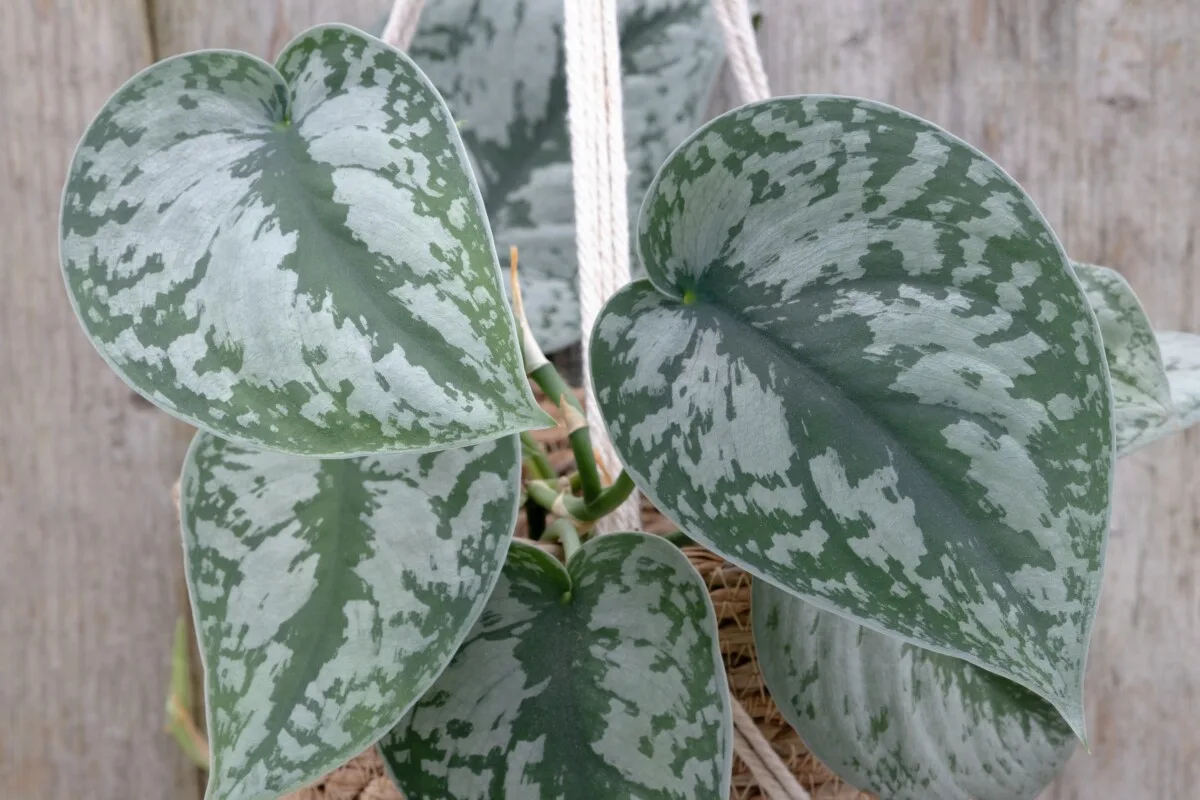
Over the years, I’ve developed a No-Pansies Allowed Policy. If plants are too fussy or hard to care for, off they go to be fussy in someone else’s home. (No offense to pansies.) And do you know what I never give away?
Pothos.
Okay, I might take cuttings, propagate them, and give them away, but I still have the first pothos I received years ago. These days, it has numerous roommates, too. There’s a lot to love about this lush, tropical epiphyte.
17 Pothos Varieties
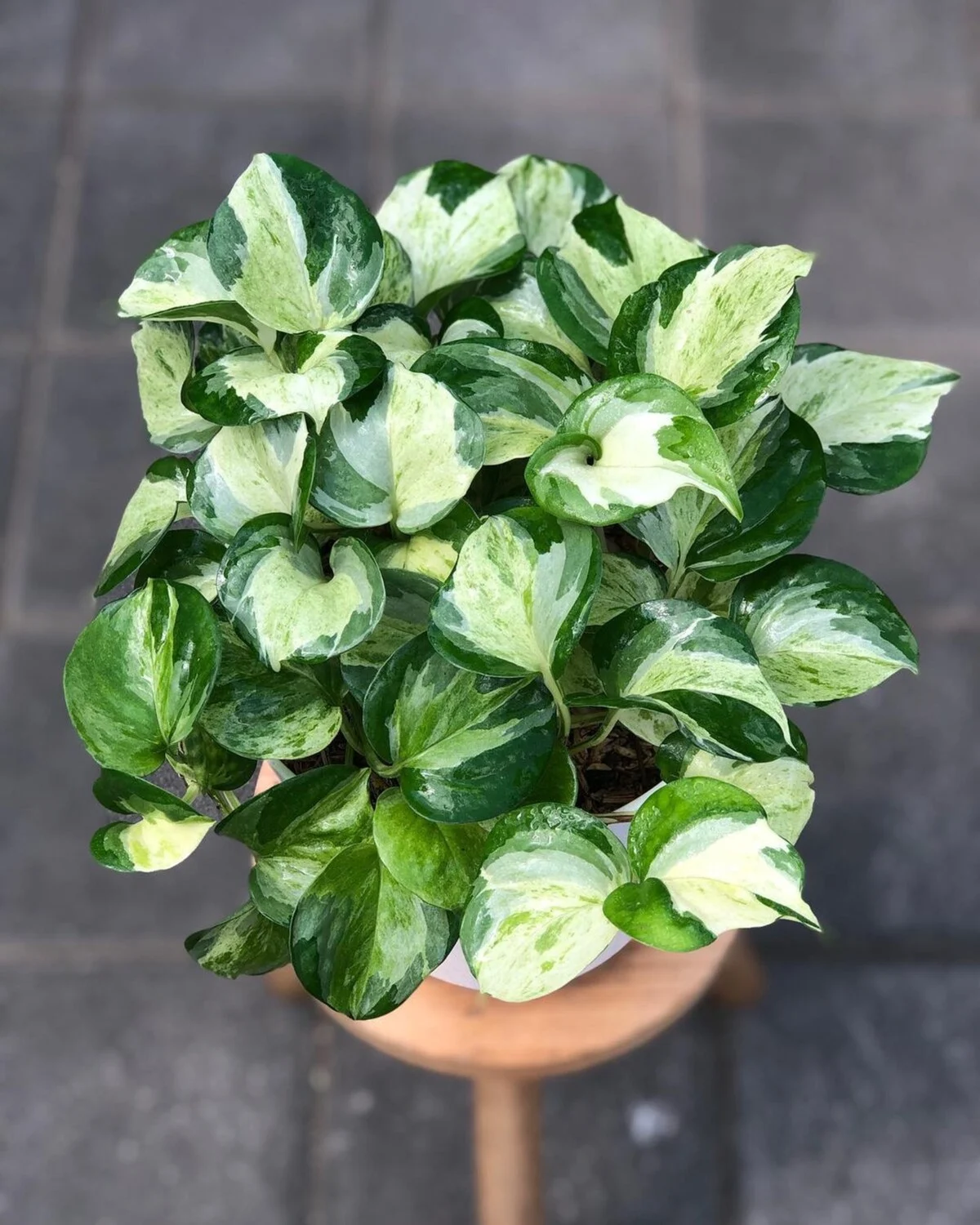
Do you know how many varieties of pothos there are? Seventeen – it’s a good number. There are enough to collect them all. But not so many that you’re overwhelmed by choice or looking for a variety that is hard to obtain.
Green, gold, white and neon – stripes, splashes, blotchy dots – there’s a pothos for everyone. If you want a great statement piece for your living room, place three different pothos together in the same style pot.
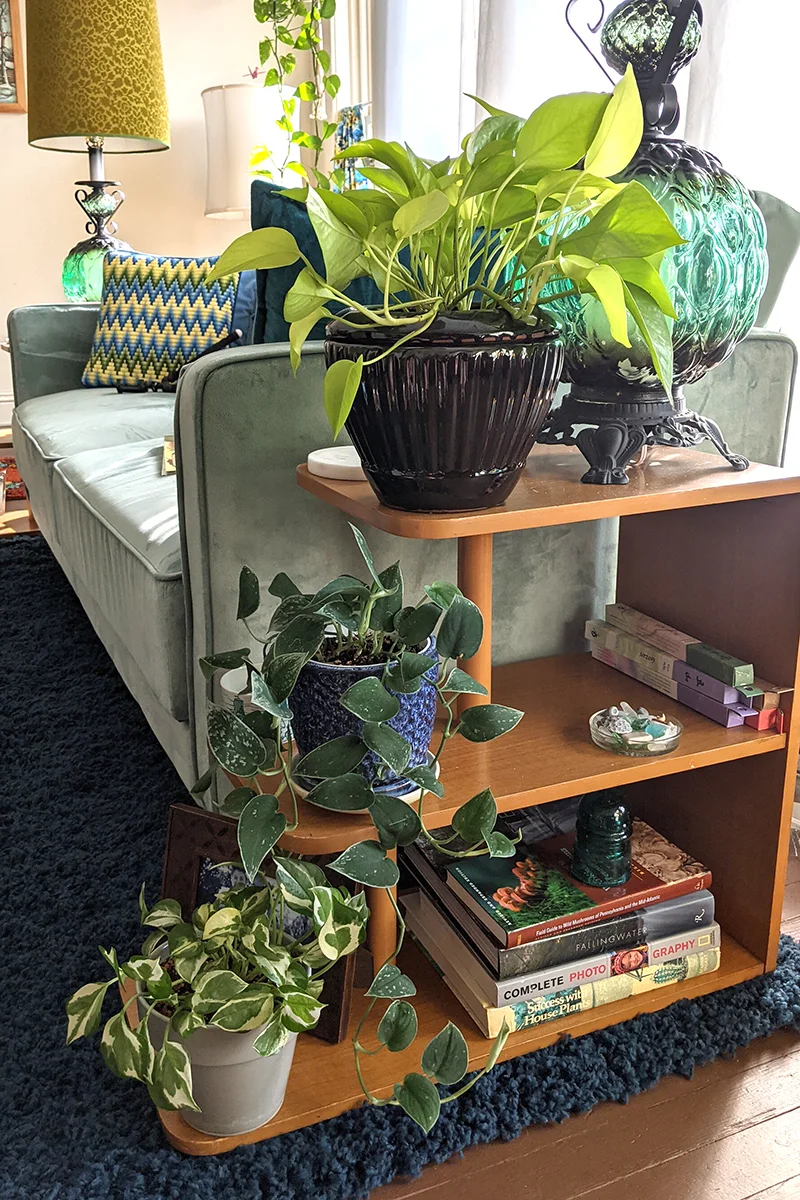
- Golden pothos – Epipremnum aureum
- Marble Queen pothos – Epipremnum aureum ‘Marble Queen’
- Neon Pothos – Epipremnum aureum ‘Neon’
- Variegated neon pothos
- Jassenia pothos – Epipremnum aureum ‘Jessenia’
- Manjula pothos – Epipremnum aureum ‘hansoti14’
- Pearls and Jade pothos – Epipremnum aureum ‘UFM12’
- Pothos N’Joy
- Cebu Blue pothos – Epipremnum pinnatum ‘Cebu Blue’
- Jade Pothos – Epipremnum aureum ‘Jade’
- Snow Queen pothos – Epipremnum aureum ‘Snow Queen’
- Harlequin Pothos
- Global Green pothos – Epipremnum aureum ‘Asaoka Second’
- Glacier pothos – Epipremnum aureum ‘Glacier’
- Silver or Satin Pothos Scindapsus pictus
- Epipremnum pinnatum (Dragon’s Tail Pothos)
- Epipremnum pinnatum ‘Baltic Blue’
The Indestructible Pothos (Well, mostly.)
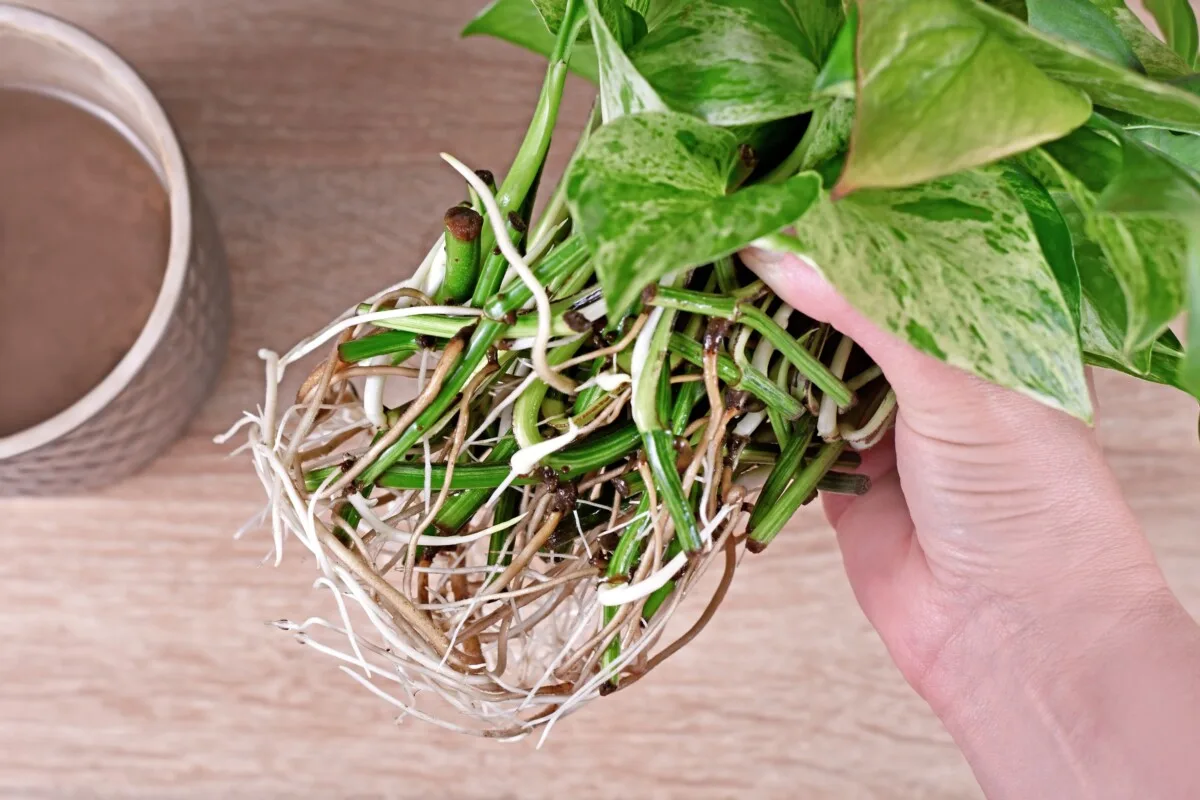
As part of my No Pansies allowed rule, plants have to bounce back if I forget to water them occasionally. And pothos certainly oblige. I would even go so far as to say they thrive with a little neglect.
It takes quite some time for their foliage to noticeably wilt if you forget to water them. And potting up? Meh, they like to be a little rootbound. Fertilizer? I mean, sure, if you insist. Most varieties of pothos are incredibly hard-wearing.
They truly are a great, easy-care plant for the novice or experienced plant owner looking for something that isn’t a time-sink.
Pothos, the Pest-Free Plant
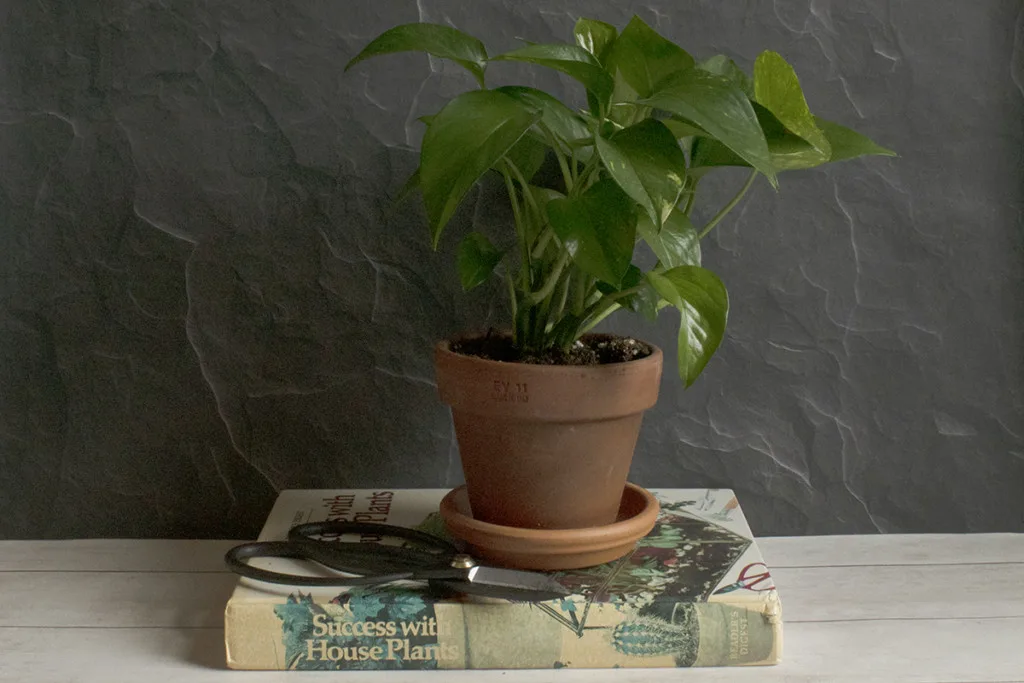
Did I mention that you rarely have to be concerned about pests with pothos? These guys are virtually pest-free. I have cleaned scale off of my hoya several times a year. I’ve had to pitch a poor parlor palm because I could not get rid of the spider mites that had taken up residence. Even when my other plants had fungus gnats, my pothos were gnat-free.
They just don’t seem to attract pests the way other houseplants do.
While they aren’t completely immune, your pothos will rarely have pest issues. Pests that can bug your pothos are spider mites, mealybugs, scale, fungus gnats or thrips.
And would it surprise you to know that pothos are generally disease-free? Really, the one thing you need to be mindful of is not to overwater them, as they are epiphytic plants. They don’t like wet feet, and sitting in soggy, damp soil will lead to root rot.
I’m trying hard to think of a downside to growing pothos, and I’m having a tough time. Oh! Sometimes, they can get leggy and lose their nice, bushy shape.
What to Do With a Leggy Pothos
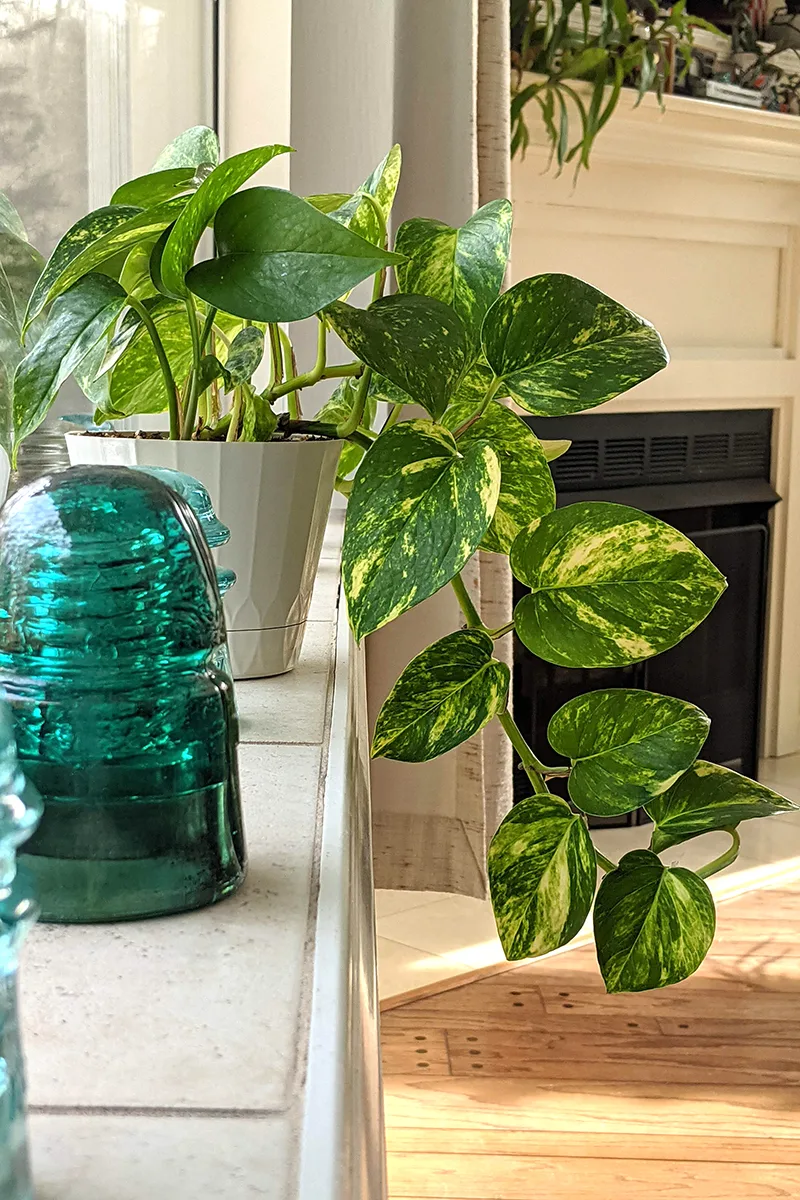
If your plant doesn’t start with a lot of stems or you don’t get the lighting right, pothos can become a bit leggy. What usually starts out as a small pot full of beautiful leaves turns into long trailing creepers inching toward the nearest light source. Interesting, but not really the look we’re going for.
You’ll notice much more stem growth between leaves and leaf nodes on these tendrils. In fact, a good way of telling whether your pothos is receiving enough light is if there are lots of leaves spaced within a few inches of each other along the stem. If leaves are more than four inches apart, your plant probably needs more light.
Like most houseplants with tropical origins, pothos loves bright, indirect sunlight.
If this term has you stumped, you’re not alone. Simply put, you want the most light possible without the plant being in full sun. Stand in the room you want to put your plant in and find the brightest spot where you can’t see the sun from nearby windows.
Of course, if it’s a north or western-facing window, you can usually get away with placing your pothos directly in a window. My N’Joy hangs in a western-facing window and loves it there.
Two Months
I advocate for letting your plant hang out in the same spot for two months. That’s long enough to see whether it’s happy in that spot. If it’s still putting out leggy growth, you need more light. Well before the two months are up, you’ll know if your plant is getting too much light, the leaves will either fade in color or show brown, crispy edges. At the first sign of either, move your plant away from the light source.
You’re Full of It, Pothos
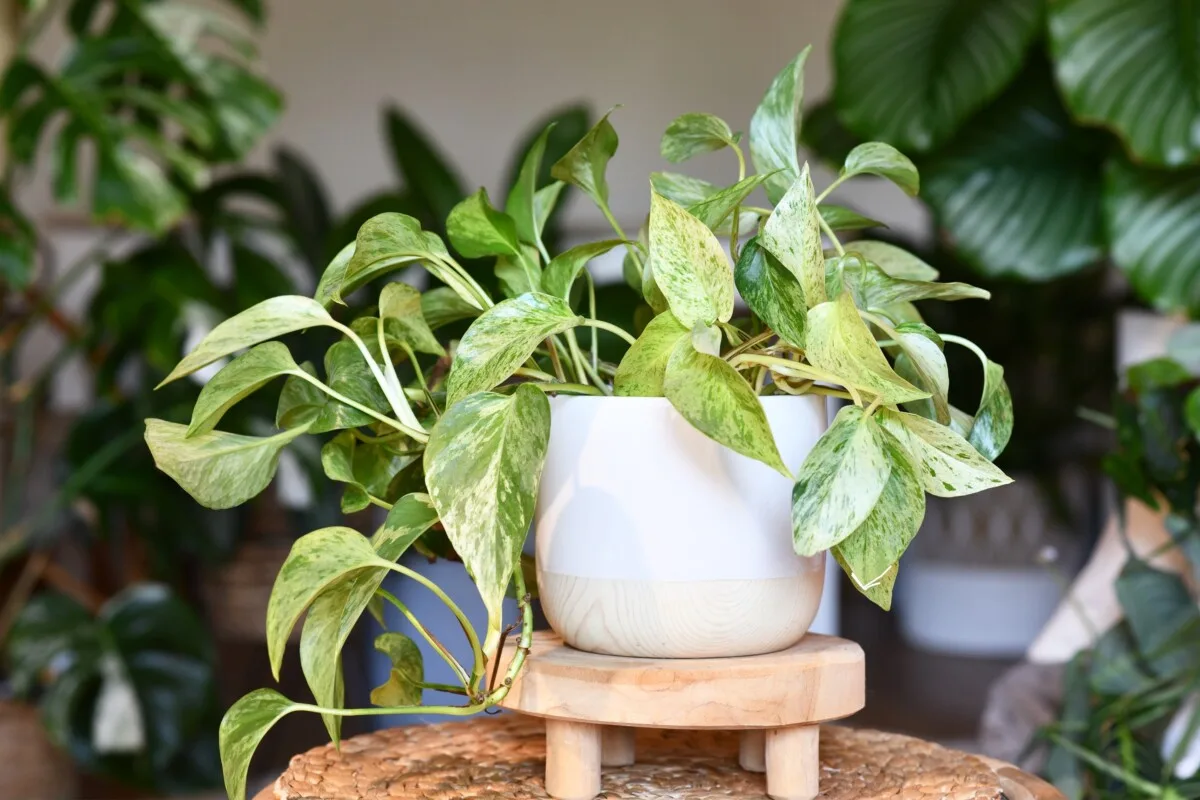
Another cause of leggy pothos is when there aren’t enough stems in the pot. You won’t have a full plant if you’ve only got 4-6 stems growing out of the soil. It seems counter-intuitive, but you want there to be enough stems in your pot to cause it to be a little cramped.
The easiest way to fix this is to cut the plant back hard.
But save those cut ends. Cut them into pieces that are roughly 3-4” long. Place one end in the soil with a node touching the soil. Poke as many in the soil as you can get. Water them consistently until they put out new growth. Between the soil-propagated cuttings and the pruned stems, within a few weeks, you’ll start to see new growth everywhere. You’re well on your way to a full pothos plant.
Speaking of Propagation
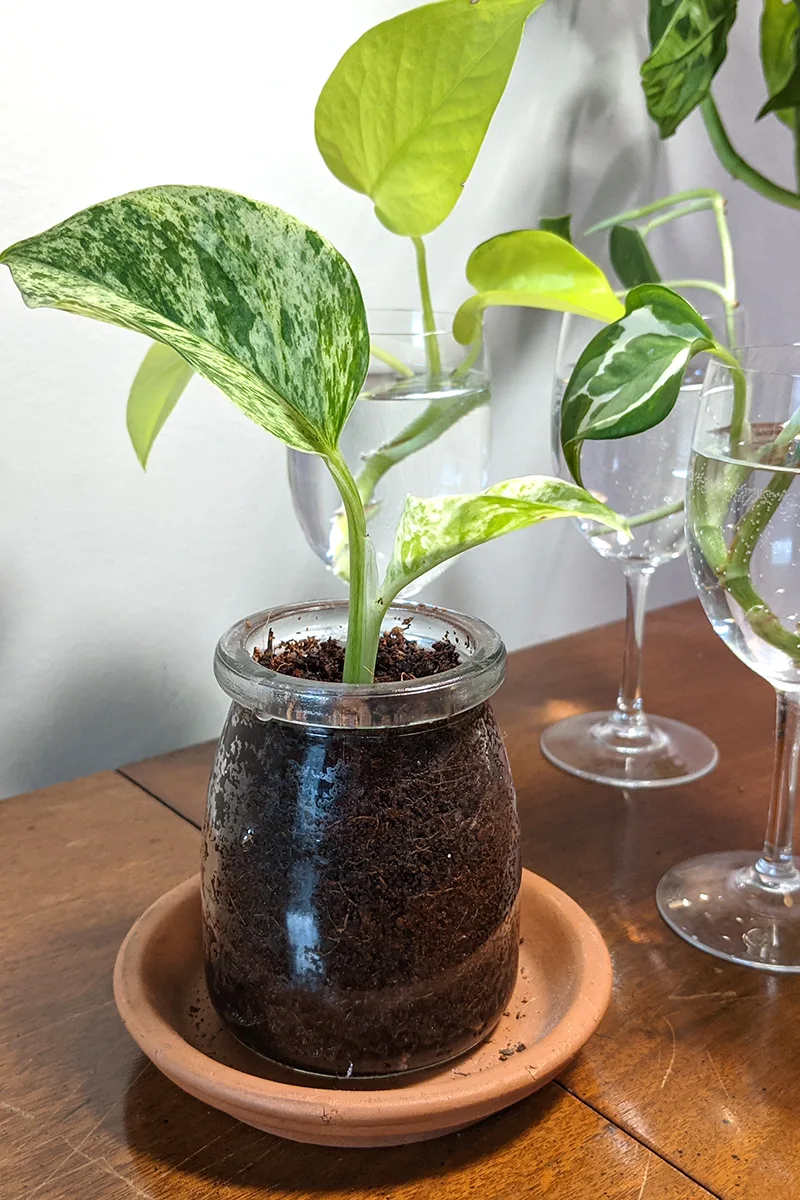
Pothos are super simple to propagate. (They even made our list of plants that are easy to propagate. You simply snip off a portion of the stem that includes a leaf node. You can start them either in soil or water. As long as you keep the soil moist (not damp), within a few weeks, the cutting will have rooted.
Don’t forget to make sure you put enough cuttings together in one pot to ensure a bushy plant.
Related Reading:
Propagate and Stay There
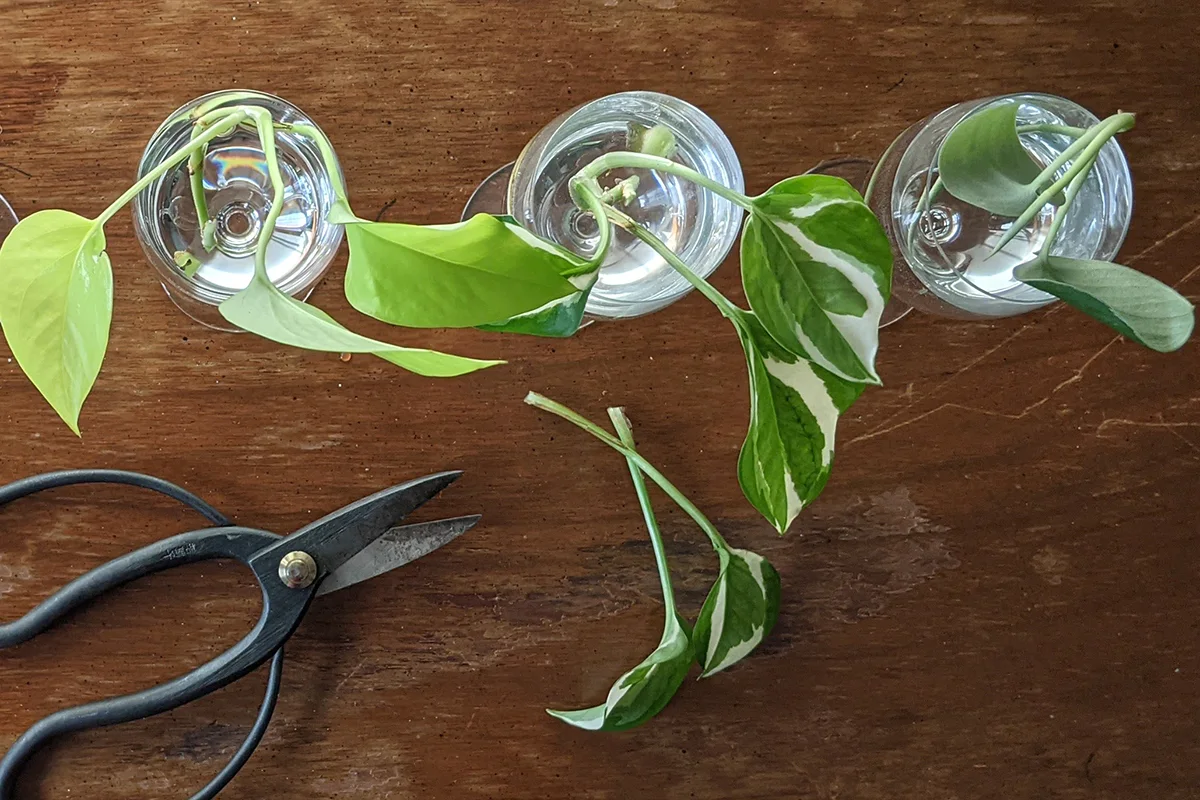
Pothos are easy to root in water as well, and the best part is once they start growing, you don’t have to repot them. Yep, pothos will grow in water, which opens up a world of beautiful display possibilities. You can learn all about growing them in water here.
Related Reading: 7 Houseplants You Can Grow In Water – No Soil Required
Watch Out, Monstera, Pothos is Coming For You
One of the coolest things about pothos is something the average houseplant owner is unlikely to see. Did you know that pothos are climbers? Yup, if you give them a sturdy, rough surface, they will climb up it. But that’s not the cool part most people will never see.

In the wild, pothos can get huge. Usually, they’re climbing up a tree. And their leaves can grow to between three and four feet long, with, wait for it, fenestrations. Oh yes, Monstera, you’re not the only one with fancy windowed leaves.
However, indoor plants simply don’t receive the light and nutrients needed for these stunning displays. You’ll have to travel to places like South America to see giant, tree-climbing pothos.
But regardless, they’re pretty amazing and beautiful plants. You should pick up a couple or maybe even seventeen.

Get the famous Rural Sprout newsletter delivered to your inbox.
Including Sunday musings from our editor, Tracey, as well as “What’s Up Wednesday” our roundup of what’s in season and new article updates and alerts.


